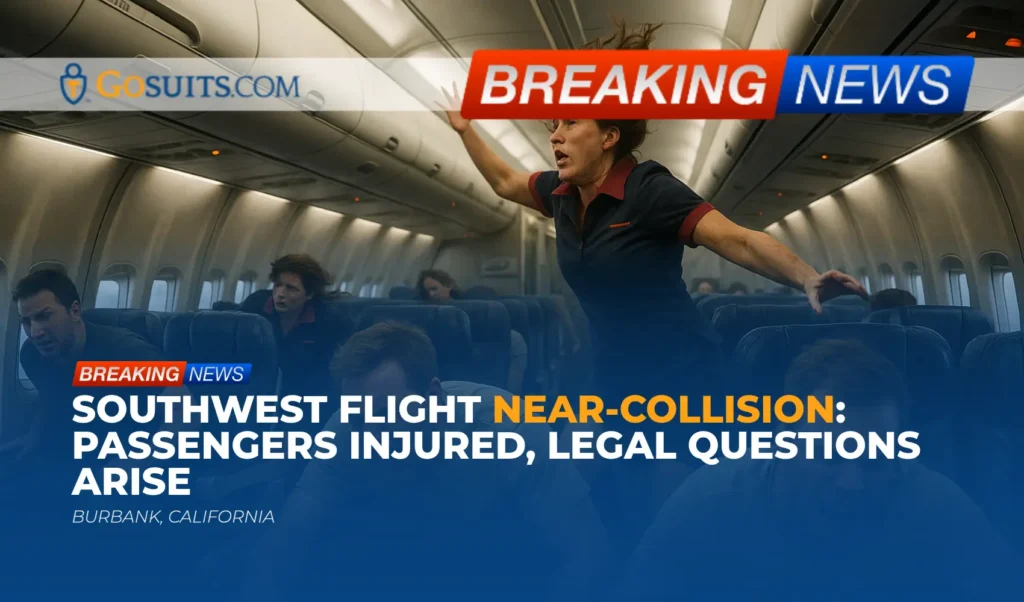On July 25, 2025, a Southwest Airlines flight, Flight 1496, traveling from Burbank to Las Vegas, experienced a near mid-air collision, underscoring the critical importance of aviation safety and the potential for severe consequences when safety protocols are compromised. According to reports, pilots received two serious warning signals at 14,000 feet, prompting immediate evasive action to prevent a collision with another aircraft. This incident resulted in a harrowing experience for passengers, with some reportedly flying out of their seats, and injuries to two flight attendants.
The Incident
The Southwest Airlines flight was en route from Burbank, California, to Las Vegas, Nevada, when the incident occurred. At an altitude of 14,000 feet, the cockpit crew received two critical warning signals indicating an imminent risk of collision. These warnings are designed to alert pilots to potential dangers, allowing them time to take corrective action. In this case, the pilots responded swiftly, executing a maneuver to avoid what could have been a catastrophic collision.
The sudden maneuver, while successful in averting a collision, resulted in significant turbulence inside the cabin. Passengers described a chaotic scene, with some being thrown from their seats due to the abrupt change in the plane’s trajectory. Two flight attendants sustained injuries as a result of the incident, though details on the severity of their injuries were not immediately available.
Understanding the Legal Implications of Near-Collision Incidents
Aviation incidents, such as near-collisions, raise complex legal questions, particularly regarding liability and the rights of those injured. In the aftermath of the Southwest Airlines incident, several legal aspects come into play:
Negligence
A primary factor in personal injury cases related to aviation incidents is negligence. Negligence occurs when an individual or entity fails to exercise a reasonable standard of care, resulting in harm to others. In the context of a near-collision, potential parties who could be found negligent include:
- Airline Operators: Airlines have a duty to ensure the safety of their passengers and crew. This includes proper maintenance of aircraft, adherence to safety protocols, and the training of flight personnel.
- Pilots: Pilots are responsible for operating aircraft safely and must follow air traffic control instructions, respond appropriately to warnings, and maintain situational awareness.
- Air Traffic Control (ATC): ATC plays a crucial role in managing air traffic and preventing collisions. They must provide accurate and timely guidance to pilots and ensure safe separation between aircraft.
- Aircraft Manufacturers: If a mechanical failure or defect contributed to the incident, the aircraft manufacturer could be liable.
Liability and Compensation
When negligence is established, injured parties may be entitled to compensation for their damages. Compensation in aviation injury cases can cover a range of losses, including:
- Medical Expenses: This includes costs for immediate treatment, rehabilitation, and ongoing care related to injuries sustained during the incident.
- Lost Wages: Individuals who are unable to work due to their injuries may be compensated for lost income.
- Pain and Suffering: Compensation may be awarded for the physical pain and emotional distress caused by the incident.
- Property Damage: If personal property was damaged during the incident, compensation can cover repair or replacement costs.

Passenger Rights
Aviation law provides certain rights to passengers who are injured as a result of airline negligence. These rights may include the ability to file a lawsuit against the responsible parties to recover damages. It’s crucial for passengers involved in such incidents to understand their rights and seek competent legal counsel to navigate the complexities of aviation law.
Aviation Safety Regulations and Oversight
Aviation safety is governed by a robust framework of regulations and oversight bodies, primarily the Federal Aviation Administration (FAA) in the United States. The FAA sets standards for aircraft maintenance, pilot training, air traffic control procedures, and overall operational safety.
When an incident like the Southwest Airlines near-collision occurs, the FAA typically conducts an investigation to determine the cause and identify any safety deficiencies. These investigations can lead to recommendations for improved safety measures, changes in procedures, or enforcement actions against individuals or organizations found to be in violation of regulations.

The Importance of Quick and Decisive Action
The Southwest Airlines incident highlights the critical importance of quick and decisive action in aviation emergencies. The pilots’ response to the warning signals was crucial in preventing a potentially catastrophic collision. Their ability to assess the situation rapidly and execute an evasive maneuver underscores the value of rigorous training and adherence to safety protocols.
In the aftermath, the passengers’ safety was paramount. While the sudden maneuver caused injuries, it was a necessary measure to prevent greater harm. The incident serves as a reminder of the inherent risks involved in air travel and the importance of remaining calm and following crew instructions in emergency situations.
Preventing Future Incidents
Preventing near-collisions and other aviation incidents requires a multi-faceted approach that includes:
- Advanced Technology: Utilizing advanced radar systems, collision avoidance technology, and automated warning systems can enhance situational awareness and reduce the risk of human error.
- Comprehensive Training: Ensuring pilots, air traffic controllers, and other aviation personnel receive thorough and ongoing training is essential for maintaining a high level of competence and preparedness.
- Strict Regulatory Compliance: Enforcing strict adherence to safety regulations and conducting regular audits can help identify and address potential safety deficiencies before they lead to incidents.
- Safety Culture: Fostering a strong safety culture within airlines and aviation organizations is crucial. This includes encouraging open reporting of safety concerns, promoting proactive risk management, and prioritizing safety above all else.
This near-collision involving the Southwest Airlines flight underscores the potential for serious injuries in aviation incidents, even when a full-scale collision is avoided. Passengers and crew members who sustain injuries as a result of such incidents have the right to seek compensation for their damages. The legal process in these cases can be complex, involving investigations by the FAA and potentially multiple parties responsible for the incident. A seasoned personal injury attorney can help victims navigate these complexities, ensuring their rights are protected and they receive the compensation they deserve for their injuries, lost wages, and pain and suffering.
In situations where negligence is suspected, it is vital to conduct a thorough investigation to determine all contributing factors. This may involve reviewing flight data recorders, air traffic control communications, and maintenance records. It’s the duty of aviation operators and regulatory bodies to ensure the skies remain safe for all travelers, and when failures occur, those harmed should have appropriate legal avenues for recourse.





